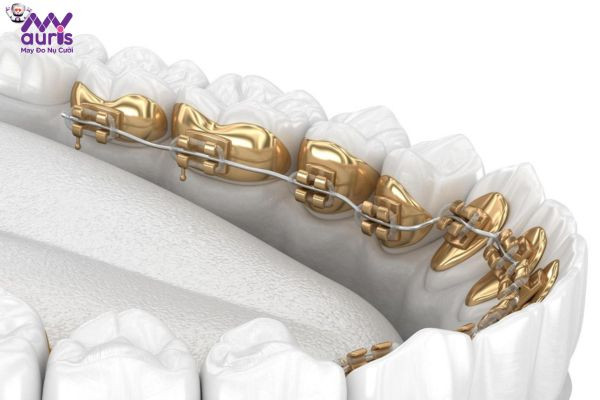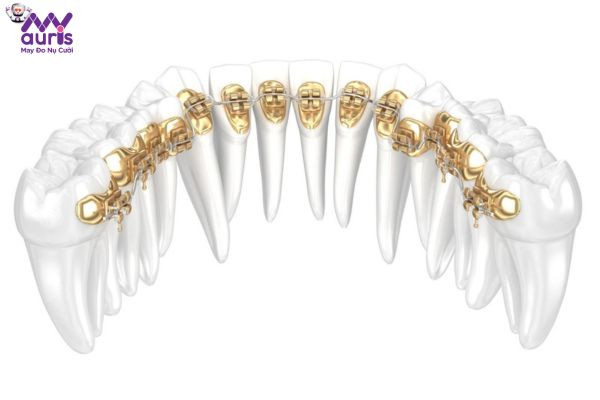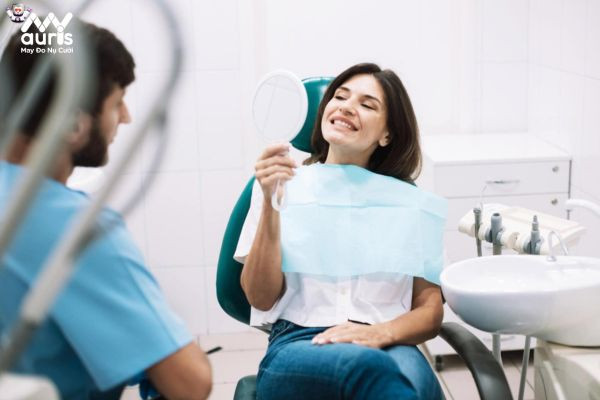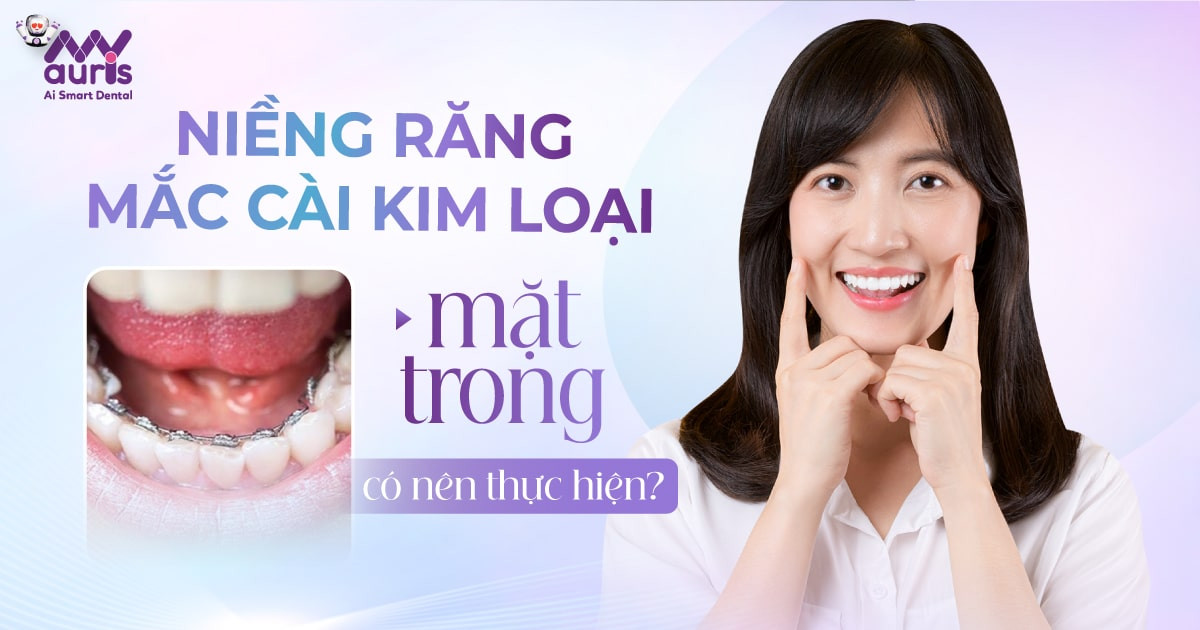With the continuous development of modern techniques in dentistry, the lingual metal braces method has been born. Gradually this technique quickly became a trend, preferred by many people. At the same time, the technique also helps straighten teeth effectively, ensuring good aesthetics for people with braces. So what are lingual braces? Who is assigned to implement it? All the answers will be provided to you by My Auris‘s dentist in the following article.
Overview of lingual metal braces technique
Inner metal braces have a similar structure to traditional braces. That means using a set of appliances including brackets and wires to move teeth to the correct position on the jaw. However, the difference is that the braces will be attached to the inner part of the tooth, opposite the tongue. Therefore, the other person will not be able to see that you are wearing braces.

This method not only improves the aesthetics of the braces patient, but it also brings absolute effectiveness like the traditional braces method. Therefore, the cost of lingual braces will be much higher than other methods.
Besides, this method also has the disadvantage of being a bit inconvenient and cumbersome, especially when first wearing braces. However, this situation will quickly improve when you get used to their presence.
Should lingual braces be performed?
As previously reported, lingual metal braces are highly appreciated for their many outstanding advantages. The most prominent of which is preserving the aesthetics of people with braces. For more details on the pros and cons to help make the decision to get braces. You need to refer to some strengths and weaknesses of the method shared by the doctor:

- CalculateHighly aesthetic: Braces are attached to the inside of the teeth, so they will not affect the orthodontist’s aesthetics.
- Highly effective: Effective method to overcome gaps, underbites, and misaligned teeth. At the same time, the force acting through the archwire system will help straighten the teeth to the correct position on the jaw.
- Applicable to many cases: The method can be performed for moderate to complex dental defects.
- Ensuring safety: The braces procedure does not cause damage to the outside of the teeth once the braces are removed. The compact design can also help prevent damage to the oral organs.
However, in reality, lingual braces also have some disadvantages that you need to pay attention to:
- Causes slight pain while wearing braces: Lingual braces will have brackets attached to the inside of the teeth. At first, it is difficult for the patient to avoid feeling uncomfortable and stuck in the lips, cheeks, and tongue.
- Difficulty in oral hygiene: Cleaning braces on the inside of the teeth will be more difficult. Therefore, more time is needed to clean teeth to ensure the oral cavity is always clean and healthy.
Who should get lingual braces?
Internal metal braces are an orthodontic method to improve oral defects. Doctors may prescribe this technical treatment for the following cases:
- Crowded, messy teeth or more teeth than average. Since then it affects the aesthetics, braces are used to help teeth grow straighter and more evenly.
- The distance between teeth is far apart, causing loss of aesthetics. Loose teeth will hinder the chewing process. Besides, food easily sticks between teeth, making cleaning more difficult.
- Some common bite deviations include: Underbite where the upper jaw cannot be seen, overbite where the lower jaw cannot be seen, crossbite, etc. These deviations not only affect the ability to chew, but also put the teeth at risk of wearing out faster. Over time, it will lead to tooth decay, or the risk of diseases such as periodontitis, pulpitis, etc.
- Protruding teeth: Also known as buck teeth, this is a condition in which the upper teeth protrude more than the lower jaw. In some cases, severe buck teeth will cause the patient to be unable to close their mouth. At this time, braces not only simply straighten teeth to correct protrusion, but it also improves the frontal angle and tilt angle of the tooth.a face.
- Underbite teeth: Also known as deep bite, this is a condition in which the lower jaw covers the upper jaw, making the face unbalanced and unaesthetic. At the same time, it also affects chewing function. Therefore, braces will help the face become more balanced and aesthetic as well as improve chewing ability.
Compare internal and external braces
Inner and outer metal braces will have certain differences:

| Comparison factors | Inner braces | Front braces outside |
| Bracket attachment position | Brackets are attached to the inside of the teeth, opposite the tongue. The other person will not be able to see that you are wearing braces | Braces are attached to the outside of the teeth. The other person can easily see the braces. |
| Braces design | The braces are designed to be smaller, to ensure no damage to soft tissue and increase comfort for the wearer. | The braces can cause some problems. It is difficult to clean teeth and also causes discomfort in daily activities. pear |
| Duration of braces | On average lasts from 18 to 36 months | On average lasts from 18 to 30 months |
| Amount of cost Treatment fee | Usually has a higher cost than conventional braces methods.
Specifically ranges from 60,000,000 – 110,000,000 VND |
It costs less and is a popular choice for many people. Because it brings efficiency and reasonable costs.
Specifically ranges from 25,000,000 – 35,000,000 VND |
Some notes when performing lingual braces
In order for the lingual metal braces method to achieve the highest effectiveness, bracers need to note a few points after:

- When you experience pain or discomfort in the early stages, you don’t need to worry too much. Use dental wax to apply to the locations where braces are attached to limit the friction of other parts of the oral cavity with the braces.
- Follow a scientific diet, providing enough nutrients for your body. Thanks to that, during and after the braces process, you will always ensure good health.
- Clean your teeth regularly and properly to avoid dental diseases. such as periodontitis, tooth decay, etc. Brush your teeth gently with a soft-bristled toothbrush, preferably 3 to 4 times a day.
- Should use dental floss, interdental brush and mouthwash for effective oral hygiene.
- Regularly follow up with your doctor and follow up with regular appointments so that the doctor can check and tighten your teeth according to the treatment regimen.
Hopefully the above information can help you know how the metal braces method works in action. For the braces process to be safe, you need to go to the dentist for the best examination and treatment. My Auris and its team of doctors will always be ready to support customers every step of the braces process, thereby ensuring safety and the best orthodontic results for each customer.
Yen Nhi





